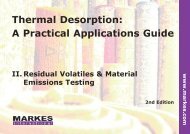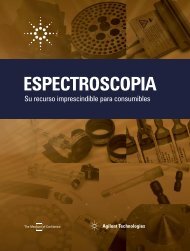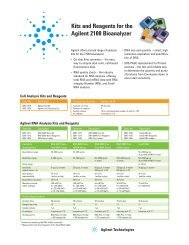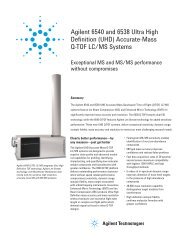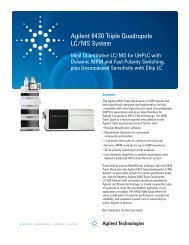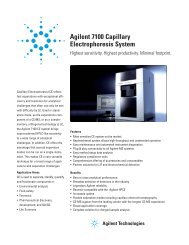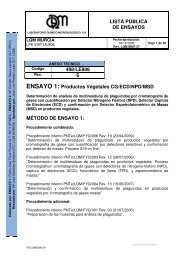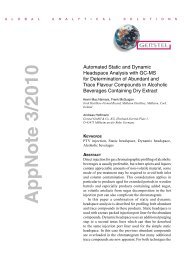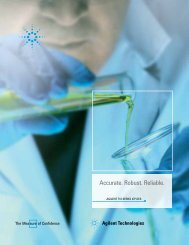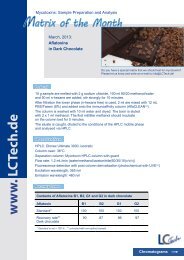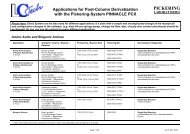LCTech - Grupo BioMaster
LCTech - Grupo BioMaster
LCTech - Grupo BioMaster
Create successful ePaper yourself
Turn your PDF publications into a flip-book with our unique Google optimized e-Paper software.
Analysis of Cosmetics<br />
NDELA and formaldehyde with one system<br />
N-Nitrosodiethanolamine (NDELA)<br />
The challenge<br />
Cosmetics, in particular mascara and skin care products, often show unacceptable<br />
concentrations of the carcinogenic compound N-nitrosodiethanolamine (NDELA).<br />
Method for analysis<br />
Das Problem<br />
The ISO/DIS 10130 is proposed as preferred method by the Technical<br />
Committee for Cosmetics of the International Organization for Standardization.<br />
This analysis with HPLC, photolysis and post-column derivatization features<br />
high specifity, minimizes the risk of measuring artefacts and allows<br />
precise quantification.<br />
www.Lctech.de<br />
NDELA is chromatographically separated from the matrix, the n-nitroso-bond<br />
is photochemically cracked at 254 nm using a UV derivatisation device. In a<br />
Griess reaction the nitrite produced is then converted into a strongly coloured<br />
azo dye, which can be detected at 540 nm.<br />
<strong>LCTech</strong> products for your NDELA analysis<br />
For both the online photolysis and post column derivatization <strong>LCTech</strong> offers<br />
suitable, reliable systems. Even the lowest concentrations, e.g. 1 ng/mL NDELA,<br />
can be detected.<br />
UV derivatizer for the photochemical<br />
cracking of the n-nitroso bond.<br />
Powerful and professional<br />
Extremely cost-effective<br />
Easy confi rmation analysis by<br />
switching off the system<br />
for the post column derivatization<br />
by the Griess reagent<br />
Specifi c reaction<br />
Precise quantifi cation<br />
Robust system<br />
Both systems are easily integrated into existing<br />
HPLC systems to make a NDELA analyzer.<br />
Analysis of formaldehyde
Formaldehyde<br />
The challenge<br />
Free formaldehyde is used for long-term stabilization in cosmetic products.<br />
The potential cancerogenity demands effective and reliable analysis.<br />
Method for analysis<br />
According to method K84.00-7(EG) chromatographic separation by HPLC<br />
column is followed by derivatization. This does not influence the equilibrium<br />
between donator and free formaldehyde. A UV/VIS or fluorescence detector is<br />
used for detection.<br />
Our solution for your formaldehyde analysis<br />
Within minutes you can rebuild your PINNACLE PCX post column<br />
derivatization system (see front side) for formaldehyde analysis.<br />
www.Lctech.de<br />
We have tested our system for you:<br />
60<br />
40<br />
20<br />
0<br />
0<br />
mAU<br />
Ordering information<br />
PINNACLE PCX TM , single pump system for post-column derivatization,<br />
0,5 mL reactor volume, for the analysis of formaldehyde<br />
P/N 1153-1022<br />
Reactor for PINNACLE PCX TM , 1 mL volume,<br />
for the additional analysis of NDELA<br />
P/N 1452-0095<br />
UVE TM , UV derivatizer, 254 nm lamp,<br />
240 V, CE certified, ready to use<br />
P/N 10519<br />
Formaldehyde<br />
Minutes<br />
1 2 3<br />
4<br />
Chromatogram of a shampoo sample,<br />
spiked with 0.05% formaldehyde,<br />
determination following K84.00-7(EG)<br />
The result is a peak for free<br />
formaldehyde without interferants.<br />
Please ask us for<br />
further information<br />
or a non-binding<br />
quotation!<br />
<strong>LCTech</strong> GmbH, Germany<br />
P.O. Box 1360 Tel. ++49(0)8081-9368-0 info@Lctech.de<br />
D-84403 Dorfen Fax ++49(0)8081-9368-10 www.Lctech.de<br />
as of April 2009, rr



